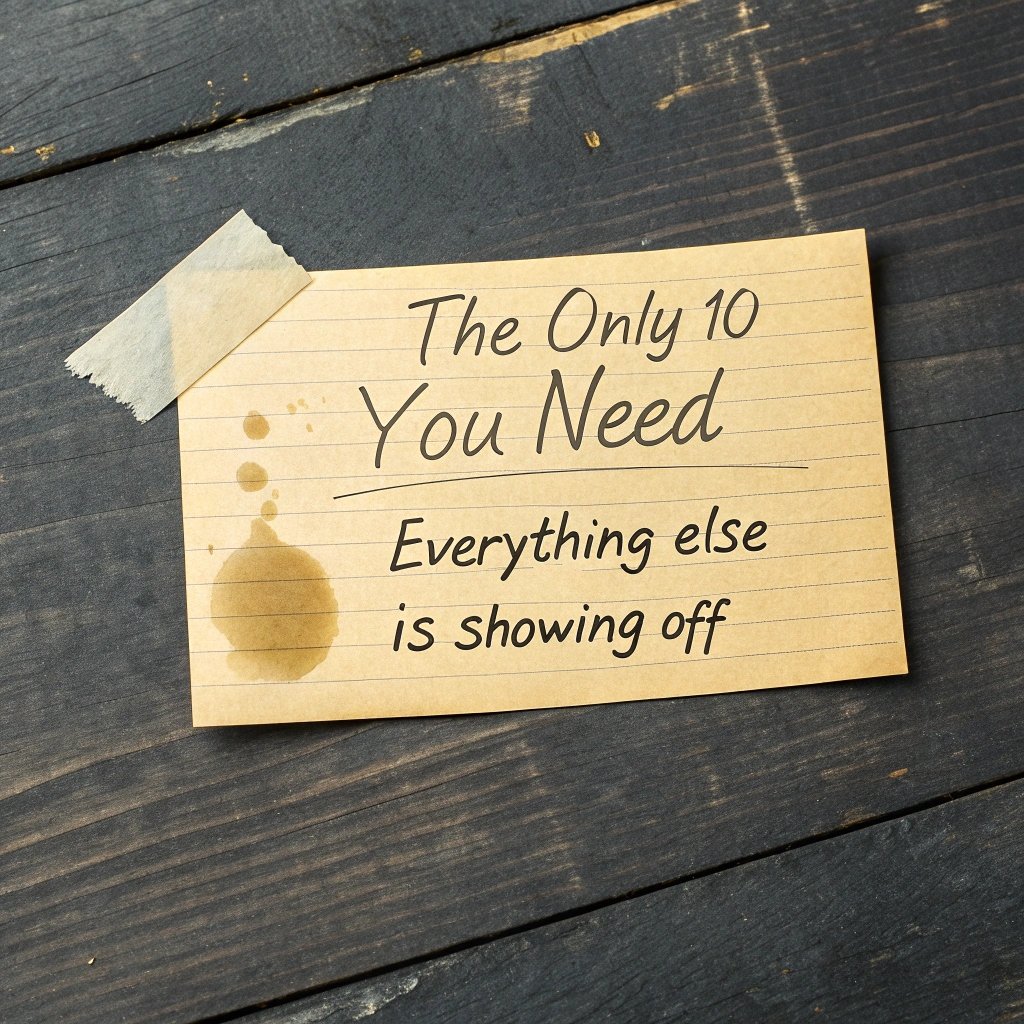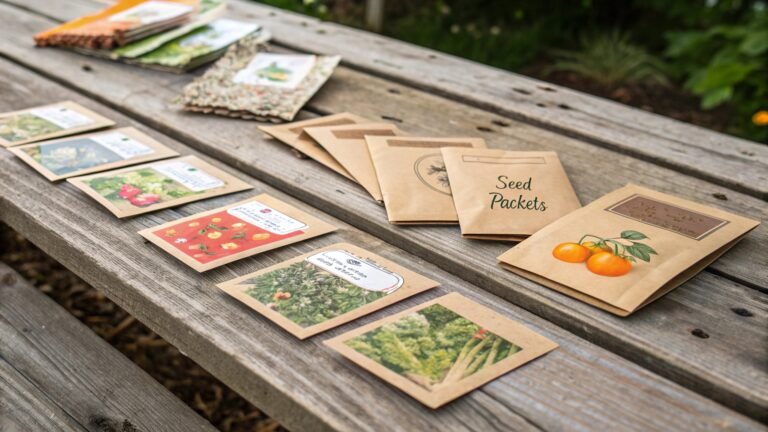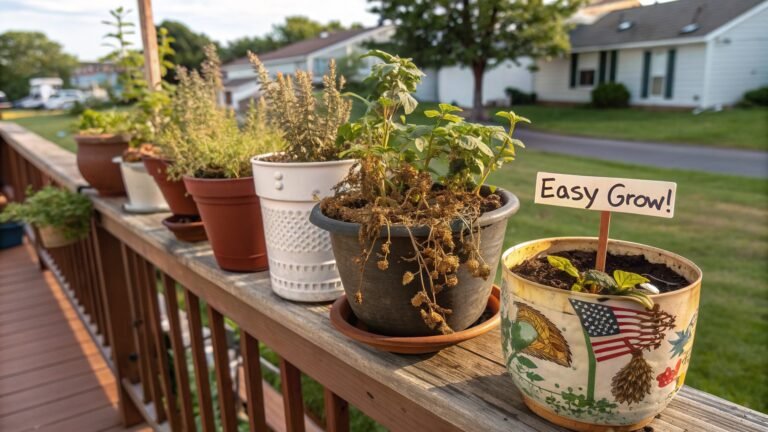Yesterday I counted 47 different "must-have medicinal plants" across my pile of gardening books. FORTY-SEVEN.
Then I found Nana's index card tucked in her recipe box. Ten plants. That's it. The woman raised six kids through everything from scraped knees to winter colds with ten plants.
The relief I felt was physical.
The Index Card That Changed My Garden
The card was water-stained and held together with tape. In Nana's careful cursive:
"The Only 10 You Need — Everything else is showing off"
I laughed out loud. Even from beyond, Nana was keeping it real.
Here's what hit me: We're drowning in information. Every blog lists different "essential" plants. Pinterest boards show gorgeous medicinal gardens with 50+ varieties. Meanwhile, we're paralyzed, growing nothing because we can't grow everything.
Nana didn't have Pinterest. She had experience.
The Master List (What Worked for Six Kids)
After using Nana's list for three years, I can share what these plants traditionally do and how our family uses them. Remember — this is our experience, not medical advice!
1. Calendula — The Skin Soother
Traditional use: Minor skin irritations, dry skin comfort How we use it: Homemade diaper cream, winter skin salve, scraped knee comfort Nana's note: "Grows like a weed, gentle as a lamb" My experience: Even my black thumb couldn't kill this one Safety: Generally safe for external use
2. Chamomile — The Gentle Helper
Traditional use: Relaxation, mild digestive comfort How we use it: Bedtime tea for kids over 1, upset tummy comfort Nana's note: "For bodies and minds that won't settle" My addition: The one tea my kids actually ask for Caution: Skip if allergic to ragweed or daisies
3. Peppermint — The Tummy Friend
Traditional use: Digestive comfort, mental alertness How we use it: After big meals, homework time pick-me-up Nana's note: "Keep it contained or it owns your yard" Warning: Seriously, plant in a pot. It's everywhere in my yard now. Note: Not for babies — too strong
4. Echinacea — The Cold Season Standby
Traditional use: Historically used at first sign of sniffles How we use it: Tea when we feel something coming on Nana's note: "Pretty enough for the front yard" My take: We use it short-term only, as traditionally recommended Safety: Not for daily use
5. Lemon Balm — The Calm-Down Plant
Traditional use: Mild stress relief, sleep support How we use it: "Bad day" tea, bedtime blend Nana's note: "Smells like happiness" Truth: It really does smell amazing **Gentle enough for children in tea form
6. Plantain — The Backyard First Aid
Traditional use: External use for bites, stings, minor irritations How we use it: Fresh leaf on mosquito bites (wash first!) Nana's note: "It's already in your yard" She was right: That "weed" by my mailbox **Kids love this "magic leaf"
7. Elderberry — The Winter Tradition
Traditional use: Cold season support in many cultures How we use it: Syrup during winter months only Nana's note: "Worth the effort to grow" Important: Only ripe, cooked berries — raw are not safe **Takes patience but worth it
8. Thyme — The Respiratory Helper
Traditional use: Cough and congestion comfort How we use it: Steam breathing, throat-soothing tea Nana's note: "Kitchen and medicine in one" Bonus: Makes everything taste better **Safe for most people
9. Lavender — The Everything Calmer
Traditional use: Relaxation, minor skin comfort How we use it: Pillow sachets, bath time, headache relief Nana's note: "If you can only grow one, grow this" My addition: Keeps moths out naturally too **Generally very safe
10. Ginger — The Settler
Traditional use: Nausea relief, warming How we use it: Car sickness, winter warming tea Nana's note: "Grow in pot, bring inside for winter" Game changer: Fresh vs dried is night and day **Safe for most, but spicy for kids

What's NOT on the List (And Nana's Reasons)
Her card had a second side: "Nice but Not Necessary (or Tricky)"
- Valerian: "Too strong, especially for children"
- Comfrey: "External only — people use it wrong"
- St. John's Wort: "Interferes with too many medications"
- Goldenseal: "Endangered and overrated"
This helped me stop feeling guilty about not growing everything.
Your "Where Do I Start?" Reality Check
If you're overwhelmed, remember:
- You don't need all 10 immediately
- Start with just 3 (next article!)
- Many are in your spice cabinet already
- Usefulness beats prettiness every time
The money reality:
Okay, let's talk actual numbers because I'm all about transparency:
- Quality medicinal seeds (the right varieties): $70–100 for a good collection
- Cheap "herb" seeds from the grocery store: $20–30 (that probably won't germinate)
- My failed attempts before finding good sources: $200+ down the drain
- Buying dried versions monthly: $50–60, forever
- Having fresh herbs when the kids are sick at 2 AM: Priceless
Here's the truth — I balked at spending $75 on seeds at first. Then I did the math:
- $50/month on dried herbs = $600/year
- Good seeds once = multiple years of harvest
- Plus, the cheap seeds I kept buying? They didn't grow. So that "saved" money was just wasted money.
What convinced me: It's not just seeds — it's the right varieties (Greek oregano vs Italian makes a difference!), from fresh stock (not 3 years old), with actual guidance on making them grow.
I spent more on my failed attempts than I would have on doing it right the first time. Classic Abby move.
The Truth About "Complete" Medicinal Gardens
Instagram medicinal gardens are gorgeous. But Nana's generation? They grew what:
- Actually helped their specific families
- Would survive their climate
- They'd realistically use
- Wouldn't require a botany degree
The pioneer women weren't trying to impress anyone. They were trying to keep families comfortable with what they had.
Sound familiar?
What These Plants Do (And Don't Do) for Us
They DO help us:
- Feel more prepared for minor issues
- Save money on some over-the-counter stuff
- Connect with traditional knowledge
- Spend less time at the pharmacy
They DON'T:
- Replace our doctor
- Cure serious conditions
- Work the same for everyone
- Solve every problem
Plants are tools, not magic. Useful tools, but still just tools.
Your No-Pressure Assignment
This week, just notice:
- Which of these do you already buy dried?
- What minor issues does your family face regularly?
- Which plants might be useful for YOUR family?
Don't buy anything. Don't plan anything. Just notice. (Teacher habits die hard!)
Ready for even simpler? Next week I'm sharing the "Just Start with 3" guide — which three plants give beginners the best chance of success (and why I wish I'd started there).
What plants do you swear by? Are there more than 10? Let's share what works!
Off to check if my ginger survived the cat,Abby
P.S. — Found another of Nana's notes: "A medicine garden you won't use is just more yard work." Woman was practical to the core.
📥 Get Nana's Practical Plant Guide
I organized her index cards into a printable guide:
- Growing tips that actually work
- When to harvest (timing matters!)
- Simple ways to use each plant
- Storage tips for your harvest
[Email box] [Button: Send Me the Practical Guide!]
Medical Disclaimer: I'm sharing our family's experience with traditional plant uses, not giving medical advice. These statements haven't been evaluated by the FDA. Nothing here is intended to diagnose, treat, cure, or prevent any disease. Always consult your healthcare provider, especially before changing any health routines or if you have medical conditions.





